Ultrasonic echo denoising in liquid density measurement based on improved variational mode decomposition
WANG Xiao-peng, ZHAO Jun, ZHU Tian-liang
(School of Electronic and Information Engineering, Lanzhou Jiaotong University, Lanzhou 730070, China)
Abstract: The ultrasonic echo in liquid density measurement often suffers noise, which makes it difficult to obtain the useful echo waveform, resulting in low accuracy of density measurement. A denoising method based on improved variational mode decomposition (VMD) for noise echo signals is proposed. The number of decomposition layers of the traditional VMD is hard to determine, therefore, the center frequency similarity factor is firstly constructed and used as the judgment criterion to select the number of VMD decomposition layers adaptively; Secondly, VMD algorithm is used to decompose the echo signal into several modal components with a single modal component, and the useful echo components are extracted based on the features of the ultrasonic emission signal; Finally, the liquid density is calculated by extracting the amplitude and time of the echo from the modal components. The simulation results show that using the improved VMD to decompose the echo signal not only can improve the signal-to-noise ratio of the echo signal to 20.64 dB, but also can accurately obtain the echo information such as time and amplitude. Compared with the ensemble empirical mode decomposition (EEMD), this method effectively suppresses the modal aliasing, keeps the details of the signal to the maximum extent while suppressing noise, and improves the accuracy of the liquid density measurement. The density measurement accuracy can reach 0.21% of full scale.
Key words: liquid density measurement; ultrasonic echo signal; variational mode decomposition (VMD); signal denoising; signal-to-noise ratio
0 Introduction
Ultrasonic echo signals for measuring liquid density are mostly low signal-to-noise ratio, non-linear and non-stationary signals. Due to the non-uniformity of the liquid medium, the ultrasonic wave frequently generates diffuse reflection and refraction, and much noise will be occurred in the echo signal. Therefore, researching and finding a denoising method for echo signal is a prerequisite and an essential step to improve the accuracy of liquid density measurement. The current methods for echo denoising mostly use time-frequency transformation. Wavelet transform[1]has a good effect on detection of non-stationary signals under certain noise conditions, however, its denoising results have a close relationship with the choice of decomposition levels; Li et al[2]proposed a wavelet basis selection method based on an energy criterion, which can better denoise the distortion signals but lacks the adaptability; Singular value decomposition(SVD)[3]has great advantages in denoising non-stationary signals, unfortunately, how to choose the correct reconstruction order is still a difficult problem in the denoising process; Song et al[4]proposed a method of using singular value difference spectrum and singular value approximation measurement principle to select the optimal reconstruction matrix order to improve the denoising effect of SVD, but Gibbs oscillation may occur during denoising; Empirical mode decomposition(EMD)[5-6]can improve the shortcomings of the time-frequency transformation with good adaptability and better reflect the local frequency characteristics of the signal. However, there are some problems such as endpoint effect and modal aliasing, which interferes with the subsequent decomposition of the signal and makes it difficult to effectively separate the useful signal from the noise; Li et al[7]proposed a method to reduce noise by combining the EMD and wavelet threshold. The standard noise deviation of each component after EMD decomposition was used to determine the wavelet threshold to denoise the vibration signal. Dragonmiretskiy et al[8]proposed a varlational mode decemposition (VMD) method, and it is an adaptive signal decomposition method to effectively pick up the frequency band of density echo signal and extract the characteristics of the echo signal. Compared with ensemble empirical mode decomposition (EEMD)[9], VMD can effectively solve the end effect and modal aliasing problems of EEMD; Li et al[10]used VMD to analyze the components of ultrasonic echo signals and accurately obtained the waveform and time of the first echo at the coal-rock interface for the purpose of identifying different media interfaces and judging media related parameters; Xu et al[11]proposed an echo signal denoising method based on VMD. After performing the VMD of the signal, it distinguished the relevant mode from the uncorrelated mode through the Bach distance, and then reconstructed the relevant mode for the purpose of denoising; Du et al[12]proposed a joint noise reduction algorithm based on VMD and wavelet energy entropy threshold (WEET) to solve the problem that the noise in the ultrasonic echo signal is difficult to remove. This method accurately restored the waveform characteristics of the echo signal; Wang et al[13]proposed a denoising method based on the combination of VMD and singular value decomposition, which can effectively solve the problems of incomplete noise removal due to modal aliasing, and the choice of the number of layers of VMD had a great impact on the decomposition effect. Xiao et al[14]proposed a VMD-layer selection method based on fast Fourier transform (FFT) to avoid excessive or insufficient signal decomposition. Ren et al[15]improved the VMD by using the energy difference as the basis for selecting the number of decomposition layers, and the improved VMD was combined with the envelope derivative energy operator to extract and diagnose fault echo signals. Liu et al[16]proposed a traditional grid search method for searching the optimal value of the decomposition parameters of VMD. In Ref.[17], the spectral envelope of FFT was adopted to identify the effective frequency components contained in the signal, and the optimal value of VMD parameters is determined according to the frequency components. Group optimization algorithms[18-19]such as genetic algorithm and particle swarm optimization algorithm can get better VMD-layer, the optimization efficiency is lower and the calculation time is longer.
In order to improve the accuracy of liquid density measurement, an ultrasonic echo denoising method for liquid density measurement based on improved VMD is proposed, where the optimal number of decomposition layers is adaptively selected by comparing the similarity of the center frequency. Therefore, the noise echo signal can be accurately decomposed, and the ultrasonic echo waveform and echo time are accurately calculated to improve the accuracy of liquid density measurement.
1 Proposed method
1.1 VMD
VMD theory is an adaptive solution to the constraint variational problem. It determines the center frequency and bandwidth of each intrinsic mode function(IMF) through continuous iteration. Each mode after decomposition is a single-component AM-FM signalμk(t), that is
μk(t)=Ak(t)cos(φk(t)),
(1)

By using a Hilbert transform, the analytical signal of each eigenmode function is obtained, and the unilateral spectrum of the signal is also obtained. It can be expressed as

(2)
An exponential term is added to Eq.(2), and the center frequency of each eigenmode function is adjusted at the same time so that the spectrum of each eigenmode function is modulated to the corresponding baseband. Then there is

(3)
The bandwidth of the modal function is estimated by calculating the squaredL2norm of the gradient, so that the sum of the estimated bandwidth of each modal is the smallest. The constraint is that the sum of the modals is equal to the input signalx(t), and the corresponding constraint variational model expression is

(4)
In order to find the optimal solution of the constrained variational model, a quadratic penalty factor and Lagrange operator are introduced to transform the constrained variational problem into a non-constrained variational problem. The extended Lagrange is expressed as
L({μk},{ωk},λ)=

(5)
The alternating direction multiplier algorithm is used to find the minimum value of the Lagrange operator iteratively. In this case, the optimal solution is the mode {μk} and center frequency {ωk} of each IMF.
1.2 Adaptive selection of the number of layers
The traditional VMD selects the number of decomposition layers based on subjective experience, which makes it difficult for the algorithm to obtain the optimal decomposition effect for echo signals with different signal-to-noise ratios(SNRs). In this paper, the similarity factor is constructed by comparing the adjacent center frequencies before and after decomposition, and the optimal decomposition level is selected based on this judgment. The center frequencyωkcan be obtained after the echo signal decomposition by VMD. Assuming that the similarity factor of the adjacent center frequencies isγ, it can be expressed as

(6)
If the front and rear center frequencies are similar after decomposition, the aliasing of adjacent modal components will occur and easily result in the inability to separate the echo signal from high-frequency noise effectively. If there is significant difference between the front and rear center frequencies, insufficient decomposition will appear and make the removal of detailed noise impossible. The experimental analysis shows thatγis between 0.70 and 0.85, and the center frequency characteristics of the front and rear modals are apparent, as shown in Table 1.

Table 1 Similarity factors of center frequency under different levels of decomposition(K=number of layers)
In this case, each IMF has no aliasing and is fully decomposed. Figs.1 and 2 are the 4-layer and 5-layer VMDs for echo signal decomposition.

Fig.1 Echo signals using 4-layer VMD

Fig.2 Echo signals using 5-layer VMD
It can be seen that compared with the 4-layer VMD, the 5-layer VMD can completely separate the echo signal from high-frequency noise. Meanwhile, it has a good effect on removing detailed noise. The steps to improve the VMD algorithm are as follows.
Step 1: The noisy echo signal is decomposed by VMD (the first decomposition layer is selected as two layers) to obtain different center frequencies.
Step 2: Compare the two adjacent center frequencies after decomposition and calculate the similarity factor.
Step 3: If the similarity factor is less than 0.70 or greater than 0.85, update the decomposition level and repeat Steps 1-2.
Step 4: If the similarity factor is greater than 0.70 and less than 0.85, the current layer number is the optimal decomposition layer number, and the effective echo signal is in the IMF component at this time.
2 Simulation and analysis
Most of these noises during the ultrasonic echo of density measurement can be regarded as random spike noise coused by electronic devices and white Gaussian noise. In order to test the denoising effect of this method, several simulations are implemented on the Matlab platform. Moreover, the proposed method is compared with EEMD, wavelet packet decomposition(WPD) and SVD in denoising effect.
2.1 Simulation and test analysis of denoising
For the purpose to verify the denoising effect of the modified VMD on the random spike noise, the FM wave is severed as the echo signal, which is convenient for observing the denoising effect, and the random spike noise is added in the range of sampling point[2 400,2 500]. SVD, WPD, EEMD and the proposed method are used for denoising and comparison, respectively. It can be seen from Fig.3 that SVD algorithm (Fig.3(c)) filters out the spike noise thoroughly, but it generates more pseudo-Gibbs oscillations at the peak part of the signal. WPD (Fig.3(d)) has a higher reduction degree to the original signal, but the spike noise is not completely filtered out. EEMD(Fig.3(e)) causes aliasing phenomenon and cannot effectively filter out the peak noise. The proposed method (Fig.3(f)) adaptively selects three-layer VMD, the noise can be well suppressed, no pseudo-Gibbs oscillations appear, and the details of the signal are better preserved well.
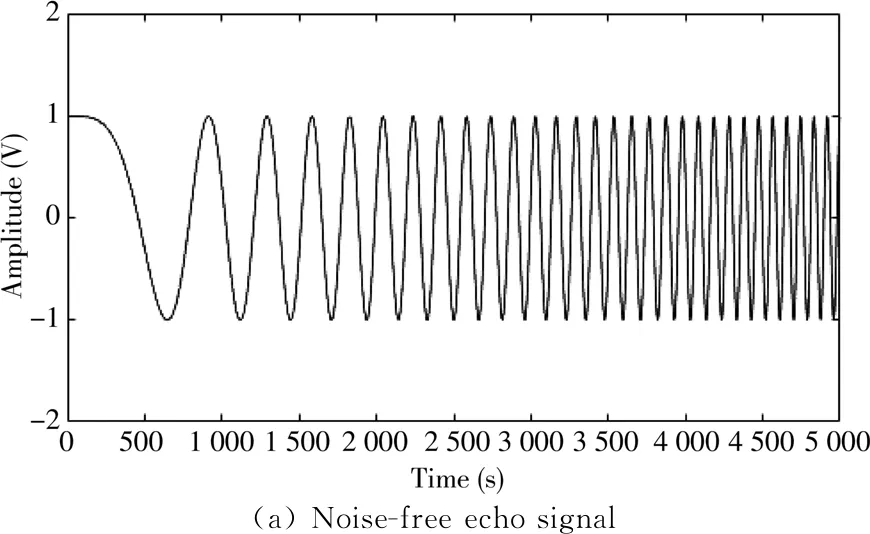



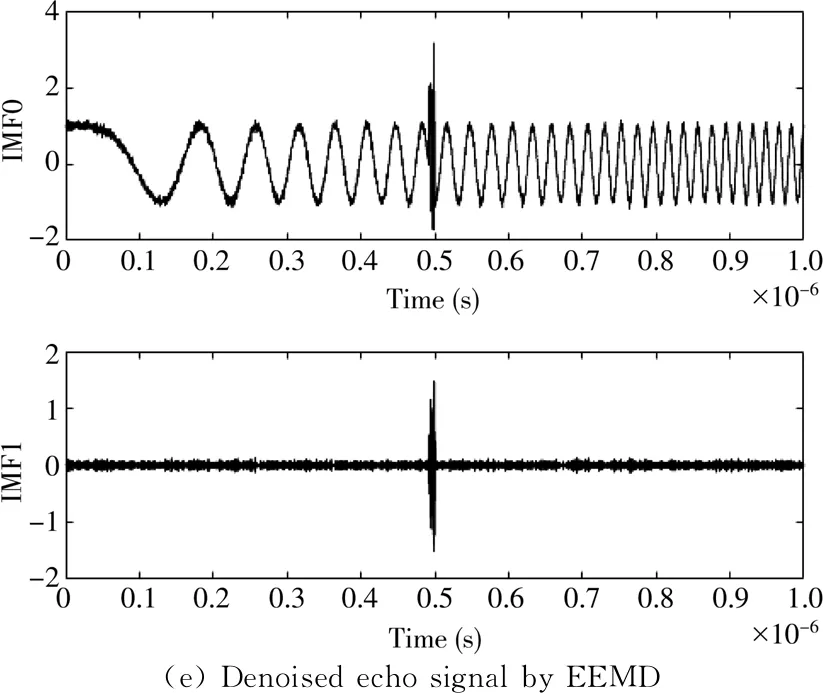

Fig.3 Denoising results of spike noise by four methods
To verify the denoising effect of the Gaussian white noise of the improved VMD, Gaussian white noise is added to the echo signal (SNR=15 dB) (Fig.4(b)).






Fig.4 Denoising results of Gaussian white noise by four methods
The SVD, WPD, EEMD and proposed method are used for denoising, respectively. The echo signals processed by the four methods are compared with the original signal, and the SNRs of the echo signals are also calculated, as shown in Table 2. It can be seen that SVD and WPD (Figs.4(c) and (d)) can effectively filter out the Gaussian white noise, however, there are more pseudo-Gibbs oscillations in the peak part of the signal, which makes it impossible to extract the echo signal envelope accurately. EEMD (Fig.4(e)) can neither effectively filter out the Gaussian white noise nor avoid the pseudo-Gibbs oscillation. The proposed method (Fig.4(f)) adaptively selects four-layer VMD to filter out Gaussian white noise, and the echo envelope is evident with the highest SNR, indicating that the denoising signal is closer to the original signal.

Table 2 Comparison of SNR and RMSE
2.2 Test and analysis of ultrasonic echo signals for liquid density measurement
In order to better evaluate the denoising effect and the actual measurement accuracy of the proposed method, an asymmetric Gaussian model is used to simulate the true ultrasonic echo of liquid density for denoising test. Moreover, it is also used to measure the density of ethanol solution.
2.2.1 Ultrasonic echo signal of liquid density model
An asymmetric Gaussian echo model is used to simulate the ultrasonic transducer with a frequency of 50 kHz[20]. The sinusoidal wave with high-frequency 100 kHz is used to simulate the high-frequency interference signal produced by the nonlinear action of the ultrasonic wave in liquid. The simulated ultrasonic echo signal of liquid density is obtained by mixing the asymmetric Gaussian modulation models(t), high-frequency sinusoidal waveh(t) and Gaussian white noisen(t).
The high-frequency sinusoidal wave interference signalh(t) is expressed as
h(t)=0.5sin(105πt).
(7)
The asymmetric Gaussian modulation model (Fig.5) is expressed as
s(t)=β×env(t-τ)×
cos[2πfc(t-τ)+ψ2(t-τ)+φ],
env(t)=exp{-α[1-r-tanh(mt)]t2}.
(8)
The simulated ultrasonic echo signal of liquid densityx(t)(Fig.6) is expressed as
x(t)=s(t)+h(t)+n(t),
(9)
whereβ=1,τ=0.01,fc=5×104,ψ=-1,φ=0,α=105,r=0.5 andm=16.

Fig.5 Ultrasonic echo signal
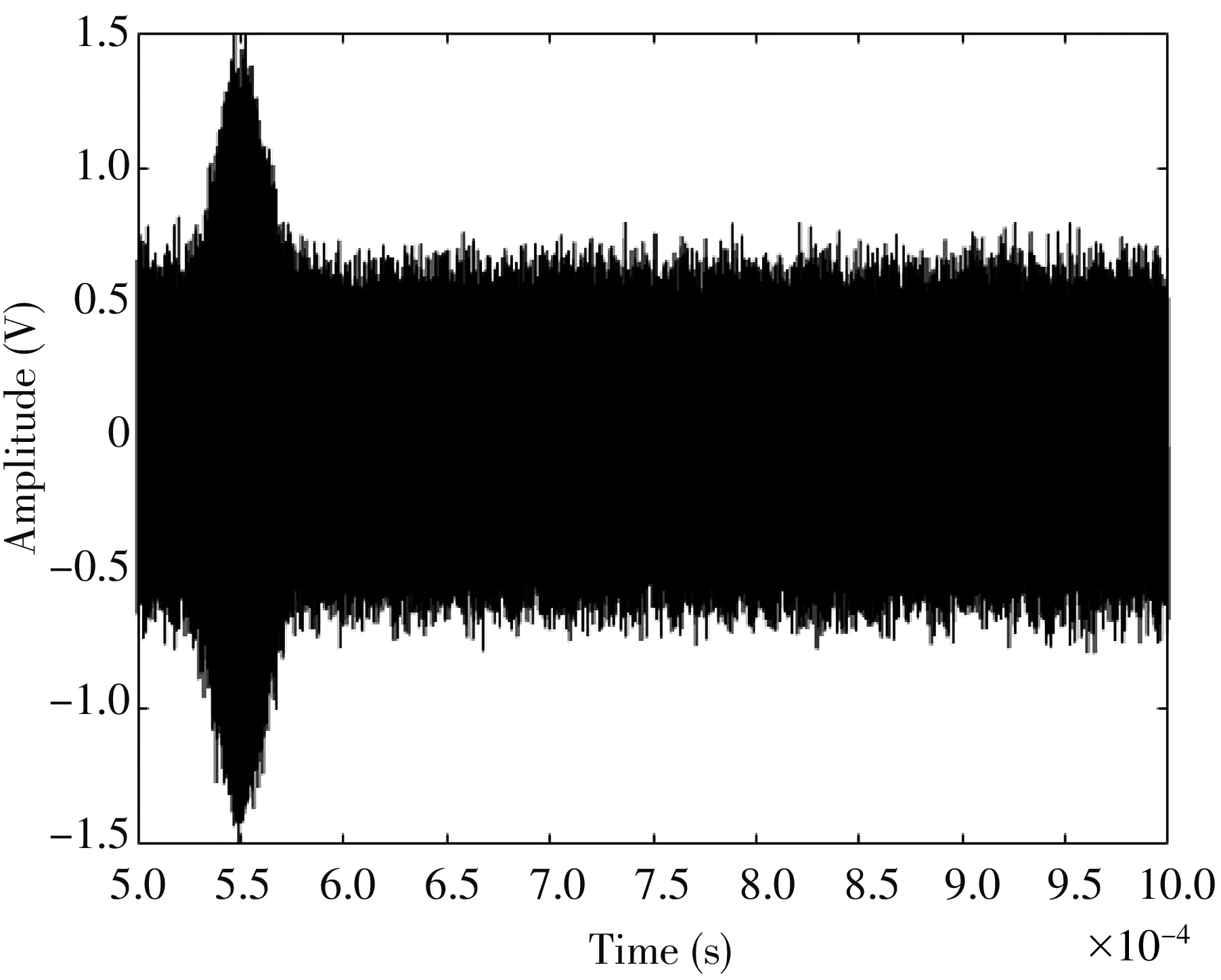
Fig.6 Noisy ultrasonic echo signal
2.2.2 Simulation analysis
Gaussian noise (SNR=8 dB) is added to the simulated ultrasonic echo signal of liquid density. The EMD, EEMD, improved SVD and proposed method are used to reduce the noise of the echo signal and extract the information of echo, respectively, and the SNRs of the echo signals are also calculated, as shown in Table 3.

Table 3 SNR and RMSE
Figs.7 and 8 show the first four components containing valid information after the EMD and EEMD decompositions of the noise echo signals, respectively. It can be seen from Fig.7 that the IMF2 of the EMD reflects the ultrasonic echo component (50 kHz) in the simulated signal, and the echo envelope is relatively clear. However, it contains much noise. Although the IMF1 reflects the high-frequency (100 kHz) sinusoidal component, it produces modal aliasing with IMF2, and the noise is not eliminated.

Fig.7 Denoised ultrasonic echo signal by EMD
In Fig.8, the IMF2 of the EEMD reflects the ultrasonic echo component. Compared with the EMD, the influence of noise is reduced. However, the phenomenon of modal aliasing with IMF1 has not been eliminated. Fig.9 is the reconstructed echo signal obtained by the improved SVD method. It can be seen that the useful echo has been completely separated from the reconstructed signal. However, the echo signal still contains much noise because the noise around 50 kHz cannot be accurately separated during the reconstruction process. Fig.10 shows the results of the proposed method, where the five-layer VMD is adaptively selected, and the first two IMF containing valid information are extracted. It can be seen that the IMF2 and IMF3 of the improved VMD have a clear waveform envelope and the highest SNR. The time spectrum of improved VMD IMF2 is shown in Fig.11. It can be seen that the frequency of IMF2 is mainly distributed at 50 kHz, and is consistent with the transmitted 50 kHz ultrasonic echo signal.

Fig.9 Denoised ultrasonic echo signal by improved SVD
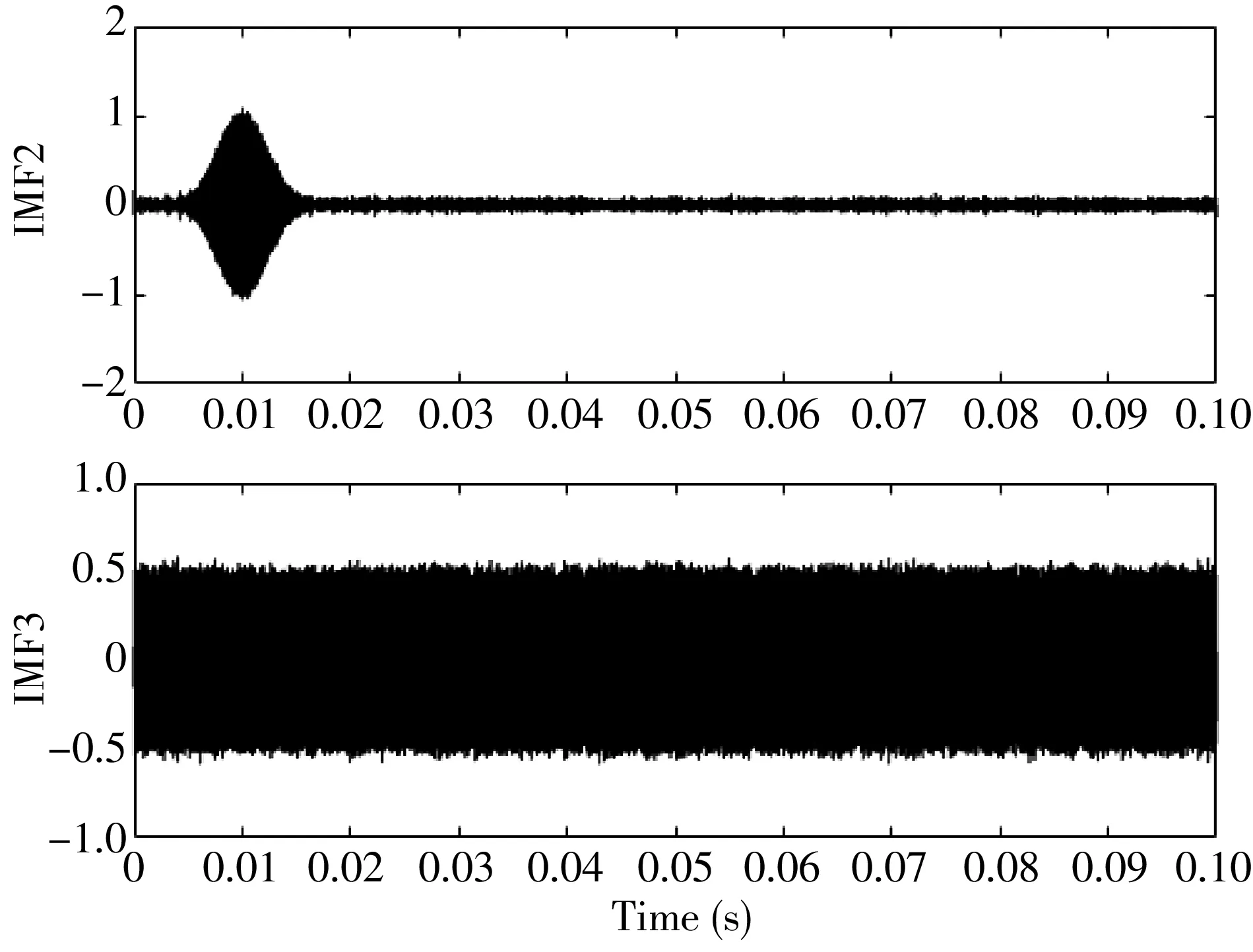
Fig.10 Denoised ultrasonic echo signal by improved VMD
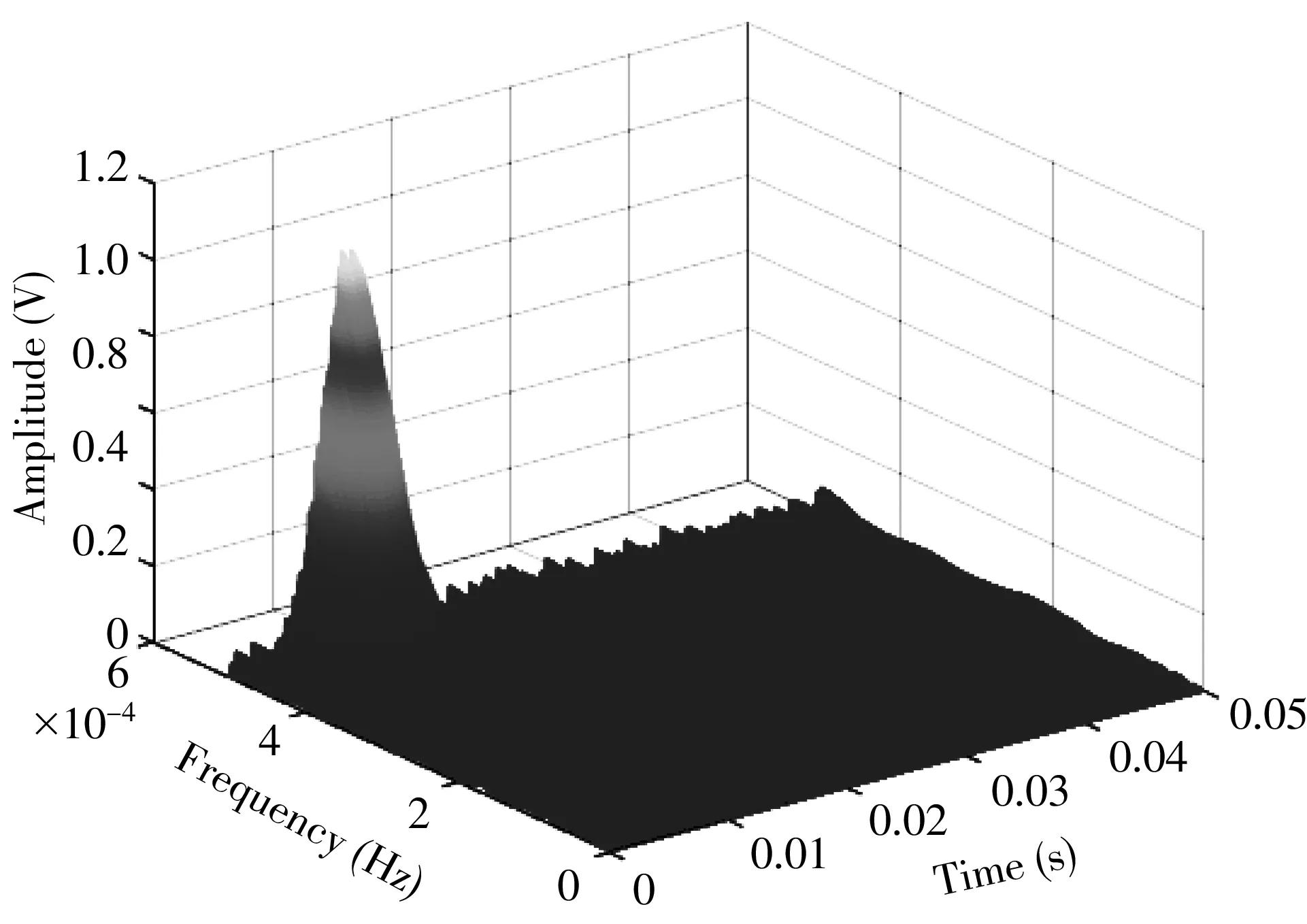
Fig.11 Time-frequency spectrum of improved VMD IMF2
2.3 Analysis of density measurement of ethanol solution
Different concentrations of ethanol solutions are used to test the measurement accuracy of the proposed method. Fig.12 shows the echo signals received and processed from the ultrasonic transducer, where the three echo signals can be observed, and the density of the ethanol solution can be calculated by the time and amplitude of the three echoes.
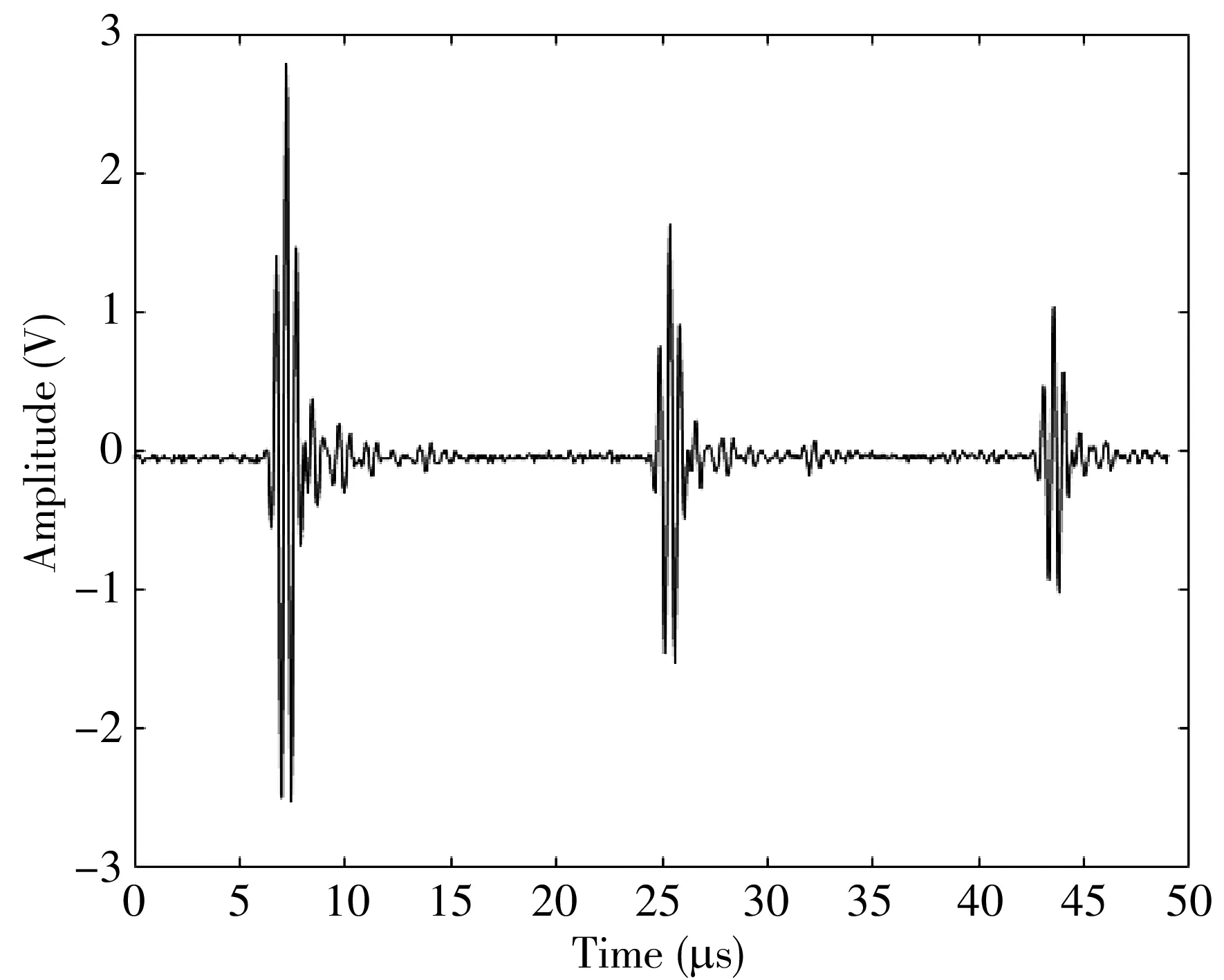
Fig.12 Echo signal of ethanol solution
Table 4 shows the density measurement results using the WPD, SVD, EEMD and proposed method, respectively. The minimum detection error of the traditional measurement method is 3.8%, and the maximum detection error of the proposed method is 2.5%, which indicates that the proposed method has a smaller measurement error. Due to the improved SNR of the useful density echo, the convergence speed of the measurement value that tends to the real value is accelerated, and the output of the measured value is relatively stable. The measurement error is relatively small, and the maximum measurement accuracy can reach 0.21% of full scale.

Table 4 Results of density measurement of ethanol solution
3 Conclusion
Aiming at the problem that low SNR in the echo signal affects the accuracy of ultrasonic liquid density measurement, VMD is improved by constructing the center frequency similarity factor. Furthermore, the improved VMD is used to decompose the received echo signal to extract the feature information of time and amplitude. The proposed method improves the SNR of the useful echo signal, suppresses the high-frequency noise interference, highlights the essential features of the useful echo signal, and improves the measurement accuracy of the liquid density. The simulation results show that compared with some existing echo detection methods, the relative error of the measurement density of this method is smaller and the accuracy is higher.
 Journal of Measurement Science and Instrumentation2020年4期
Journal of Measurement Science and Instrumentation2020年4期
- Journal of Measurement Science and Instrumentation的其它文章
- Hydraulic cylinder control of injection molding machine based on differential evolution fractional order PID
- Automatic detection and removal of static shadows
- Pattern recognition of optimal traffic path based on HMM
- Model predictive current control for PMSM driven by three-level inverter based on fractional sliding mode speed observer
- Three-dimensional atomic force microscopy based on tailored cantilever probe with flared tip
- An active temperature compensated fiber Bragg grating vibration sensor for high-temperature application
